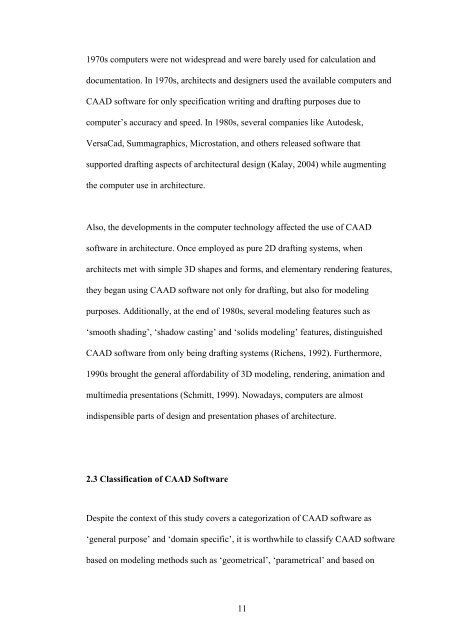critical analysis of the absence of interior - Bilkent University
critical analysis of the absence of interior - Bilkent University
critical analysis of the absence of interior - Bilkent University
You also want an ePaper? Increase the reach of your titles
YUMPU automatically turns print PDFs into web optimized ePapers that Google loves.
1970s computers were not widespread and were barely used for calculation and<br />
documentation. In 1970s, architects and designers used <strong>the</strong> available computers and<br />
CAAD s<strong>of</strong>tware for only specification writing and drafting purposes due to<br />
computer’s accuracy and speed. In 1980s, several companies like Autodesk,<br />
VersaCad, Summagraphics, Microstation, and o<strong>the</strong>rs released s<strong>of</strong>tware that<br />
supported drafting aspects <strong>of</strong> architectural design (Kalay, 2004) while augmenting<br />
<strong>the</strong> computer use in architecture.<br />
Also, <strong>the</strong> developments in <strong>the</strong> computer technology affected <strong>the</strong> use <strong>of</strong> CAAD<br />
s<strong>of</strong>tware in architecture. Once employed as pure 2D drafting systems, when<br />
architects met with simple 3D shapes and forms, and elementary rendering features,<br />
<strong>the</strong>y began using CAAD s<strong>of</strong>tware not only for drafting, but also for modeling<br />
purposes. Additionally, at <strong>the</strong> end <strong>of</strong> 1980s, several modeling features such as<br />
‘smooth shading’, ‘shadow casting’ and ‘solids modeling’ features, distinguished<br />
CAAD s<strong>of</strong>tware from only being drafting systems (Richens, 1992). Fur<strong>the</strong>rmore,<br />
1990s brought <strong>the</strong> general affordability <strong>of</strong> 3D modeling, rendering, animation and<br />
multimedia presentations (Schmitt, 1999). Nowadays, computers are almost<br />
indispensible parts <strong>of</strong> design and presentation phases <strong>of</strong> architecture.<br />
2.3 Classification <strong>of</strong> CAAD S<strong>of</strong>tware<br />
Despite <strong>the</strong> context <strong>of</strong> this study covers a categorization <strong>of</strong> CAAD s<strong>of</strong>tware as<br />
‘general purpose’ and ‘domain specific’, it is worthwhile to classify CAAD s<strong>of</strong>tware<br />
based on modeling methods such as ‘geometrical’, ‘parametrical’ and based on<br />
11
















